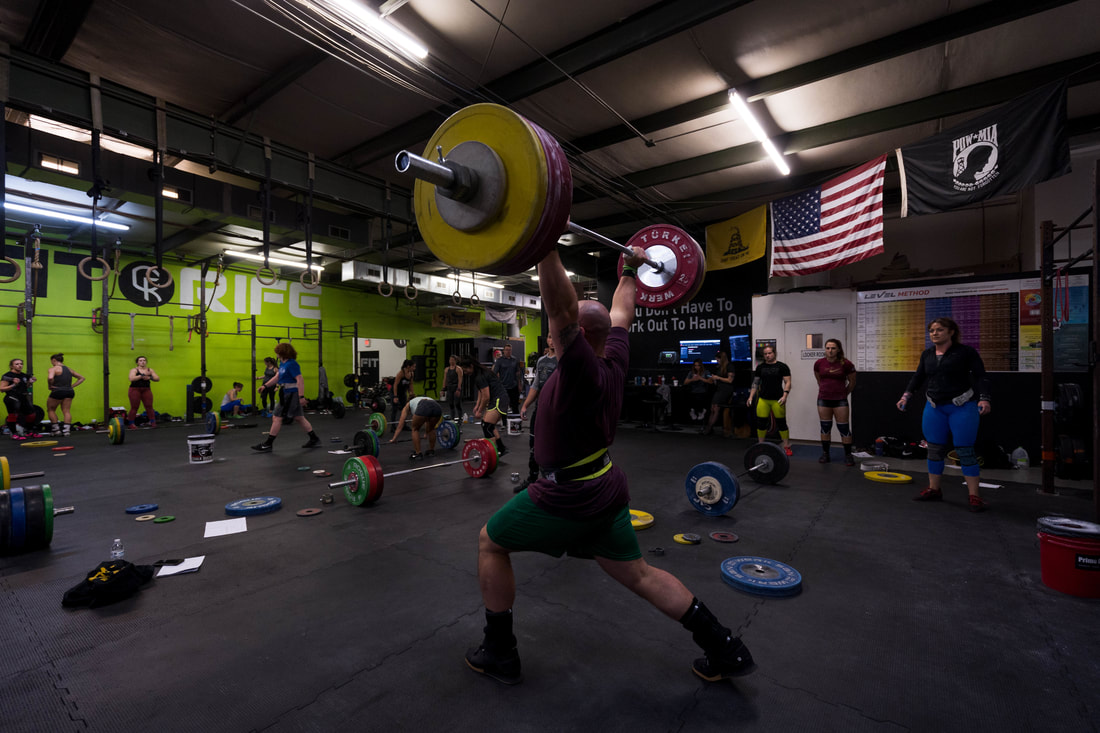|
This Blog was originally posted here: joesbarbell.com/2017/04/26/make-time/ Having a garage gym is great. The time you don’t waste in the car alone traveling to and from the gym makes it worth having. Also, as a dad who wants his kiddos to take up training I like having my kiddos around the gym. I want them to access the gym and equipment to tinker on their own. I also like for them to see mom and dad getting after it regularly. This aspect of a garage gym is also worth its weight in kilos. A 2010 article in the Journal of International Pediatrics demonstrated that children who perceived their parents as physically active were themselves physically active That said, to successful train in your own garage set up you need to have few rules in place. 1 – Carve out a designated space. Your gym space needs to be your gym space. This needs to be the place you get work done. I am a big fan of a compartmentalized place that is just for training. We don’t even park the cars in the garage. Now, we do store some things in the garage along with the training gear but the matts are for training and that is that. If you don’t have the space to carve out your very own training place, but do get after it at home, I would suggest setting up the same way, in the same place, all the time. My wife for instance likes to do yoga in the living room with the kids. When she does this she does it in the same spot and has a routine for setting that up, but more on that later. The point is your at home training space needs to be as consistent a training place as a stand along gym as possible. This will ensure for more consistent training. 2 – Have a pre training routine. If you are going to be training at home you need to set your switch and hit the go button! Regardless of the amount of time I have to train or the type of training I am going to get into I do a few things beforehand to set the mood. My routine consists of writing down my work, informing my little ones that daddy is hitting the gym, and setting my computer up for tunes. Yes, these are really simple things. But, they also ready my mind and my kids for the training session to come. 3 – Have rules in place I mentioned above that I like to have my kids around when I hit the weights. Check out this video from a recent session and you will see my son is a few feet away as I perform a Jerk variation. Inevitably misses happen and unpredictable events take place. Never, not once, or ever is one of those events allowed to be one of my kids getting hurt. In order to keep my kids safe while I’m moving heavy loads the kiddos know, and I check to make sure they are out of danger. One rule is that when Daddy is training kiddos have to be on the other half of the garage or off the training mats. As you can see Mason understands this and stays clear. Be sure to have, and most importantly, enforce ground rules for the safety of participants and nonparticipants. 4 – It’s not your job to throw them a party Now this rule is for those of us with kiddos at home while training is going down. It may also apply to a spouse or frisky friend so be sure to still pay attention if you don’t have kiddos. I don’t go out of my way to schedule events for my kids when I train. As I mentioned before I want them around training, plus I want them to take care of their own business and be independent – which mine are. I see parents over schedule, over stimulate, and underestimate their child’s ability to fill time – all the time. If you do any of these things your kiddos will be dependent on you to get through every minute of the day and that will inevitably eat up your training time. On the other hand, don’t schedule anything. Don’t lay out extra stuff. In fact, don’t go out of your way to set up anything to keep your kids busy at all. I think you’d be surprised at how well they will fill in the gaps. I am fortunate enough to have three kids close in age. Mason is 6, Charlie is 4, and Luci is 2. These 3 play very well together because they spend a lot of time playing well together! And yes, they play with each other. When Daddy trains that is not code word for movie time. When Daddy trains that does not mean the iPads come out. Take the drawing of the New York skyline that Mason created yesterday. The only hand I had in the creation of this picture was taking the picture and providing the freedom for him to be creative. While he did this he also pulled out a few extra crayons and pieces of paper for his little sisters to create as well. The major takeaway is when Daddy trains that is his time, but it’s also the kids time! They can play, train, create, and figure out how to manage themselves quite well. That said, these are still little kids. They can’t manage themselves for hours. Give yourself a time frame so you can truly be productive. Our house is not Lord of the Flies. 60 minutes tops is what my kids get to be independent! Not to mention when they are in that state I am a door away and constantly checking in! If you don’t have a garage or home set up I would highly recommend it! I would also highly recommend coming up with a system so you can train productively. Mine is simple. I Carve out a space, I set the stage, I have some rules, and I make that time productive by making it mine. If you train at home I’d love to know what your system is. If you don’t train at home try mine and let me know what you think. Comment below, give this a share!
2 Comments
As part of East Coast Gold Weightlifting we have access to some of the best athletes and coaches in the USA. This article was written by my coach and President of ECG , Phil Sabaitini
The link for the original article is here : eastcoastgold.org/2018/10/04/philosophy-stop-using-the-word-fix/ So often, I hear athletes say things like “I’m going to come in to fix my Jerk”, or “Can you fix my snatch?” STOP! This is implying that one cue, one exercise, or even within one day that you can miraculously obtain perfect technique in a certain area. Two things that are very important in the sport of Weightlifting: Patience and Expectation Management. The thought that you can spend minimal amount of time and obtain a quick fix is absurd. It offends the long-time athletes and coaches that have spent decades trying to correct improper movement patterns. Great athletes of any sport have spent countless hours in perfect conditions perfecting a very specific technique that allows for them to excel at their sport. For example, the baseball pitcher who seeks a perfect, fluid wind-up, or the gymnast who seeks the perfect dismount and the quarterback who seeks the perfect throwing motion. These movement patterns weren’t built or rebuilt in one single session. In some cases, it has taken a lifetime to finally have the proficiency that the training for it deserves. One thing that those athletes who have succeeded in doing so have in common are the 2 attributes listed above; Patience and Expectation Management. Consistency and exposure to the movement is what allows for us to create the neurological education that we call “muscle memory”. Unfortunately, this is also what has allowed us to create an improper movement pattern to begin with. The challenging part is that not only do we have to learn how to do the movement correctly, but it also may involve an unlearning of the previous movement in order to obtain that. This process takes months and years. The more times you can do it correctly, the closer you get. This is why having patience is essential to the process. In order to create this new neurological pattern, we must work at it. This process is full of frustration, fatigue, frustration, regression, and more frustration. But, perspective is a very powerful tool that can make this process much more enjoyable. The ability to manage your expectations on both a small and large scale and from a short-term “fix” to a long-term adaptation will dictate your level of frustration. Managing expectations takes more than just patience alone. It means that you must understand that you may not make progress every day. You may have to understand that sometimes it may feel like you have gotten worse at the movement and that you have no clue what you are even doing at times. Also, you must understand that some days fatigue will get the best of you and even if you are trying to correctly perform movements with certain weights, it is proving to be extremely difficult. Lastly, manage the time frame in which you are expecting perfection. Learn to accept small victories when they come and learn from the days that they don’t. Switch your focus to a process rather than a performance, and learn to embrace that process and attack it with enthusiasm and positivity. Understand that progress is not always shown in the amount of weight that is on the barbell. And be in it for the long-haul, because it is a long haul. PHIL SABABTINI Come join team PFP and ECG by emailing me at : [email protected] |
PFP BArbellCoaches and Athletes will be contributing to this blog. We will be discussing lifting tips, smashing goals, and much more. Archives
November 2023
Categories |


 RSS Feed
RSS Feed